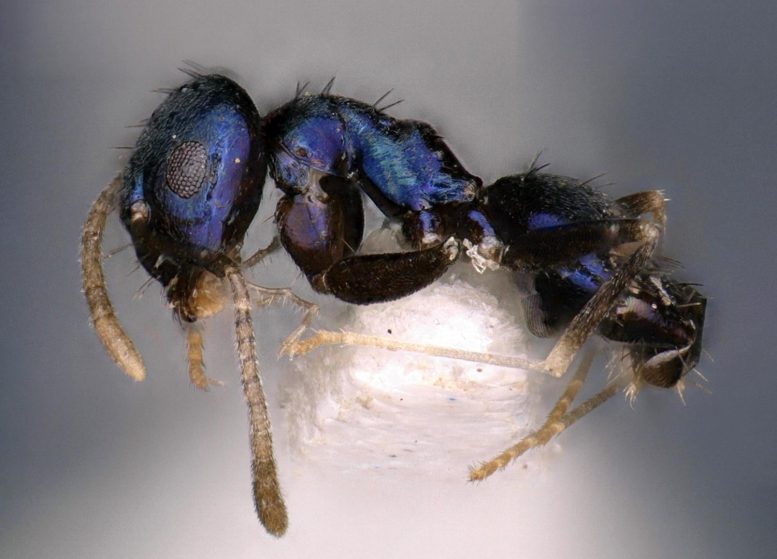Newly Discovered Blue Ant Species Shines in India

A group of researchers in India have distinguished a new species of blue ant, Paraparatrechina neela, which enriches the unique biodiversity of the Eastern Himalayas while prompting queries about its ecological importance. Credit: Sahanashree R, Edited
An exceptional blue ant, branded as Paraparatrechina neela, has been discovered in Arunachal Pradesh, India by a team of entomologists. This discovery, accomplished during the Siang Valley biodiversity resurveys, underscores the distinct fauna of the Eastern Himalayas, kindling curiosity about their ecological roles and evolutionary characteristics.
This newly found blue ant species, which was discovered in Yingku village in Arunachal Pradesh, northeastern India, is unlike the usual red, black, or brown ants. The new species is part of the rare genus Paraparatrechina and has been named Paraparatrechina neela. The term "neela" signifies the color blue in many Indian languages, which splendidly pays homage to the ant's unique color.
Entomologists Dr. Priyadarsanan Dharma Rajan and Sahanashree R of Ashoka Trust for Research in Ecology and the Environment (ATREE) in Bengaluru, in conjunction with Aswaj Punnath from the University of Florida, teamed up to describe this striking new species. Their scientific description of the ant was published in the open-access journal ZooKeys.
On one evening, when the researchers were exploring a tree hole about 10 feet up in a steep cattle track in the remote Yinku village, they saw something sparkling in the dim twilight. The insects they aspirated turned out to be ants, to their surprise.
Paraparatrechina neela. Credit: Sahanashree R
An expedition to Siang valley in Arunachal Pradesh to conduct repeat surveys of its biodiversity led to the discovery of the ant. The initial Abor expedition from the era of colonial administration in India was a retaliatory military mission against the native people there in 1911-1912. The scientific team also joined this military mission to record the natural history and geography of the Siang Valley.
This voyage faced a number of obstacles, including perilous terrain, challenging weather conditions, and opposition from local tribes. Despite these difficulties, it managed to investigate and map significant portions of the Siang Valley region, documenting and classifying every organism, from plants to mammals, that were found. The findings were published in several volumes from 1912 to 1922 in the Records of the Indian Museum.
A century later, a group of researchers from ATREE along with a documentation crew from Felis Creations Bangalore launched a series of expeditions under the banner of “Siang Expedition” in order to reassess and record the biodiversity of the region. The National Geographic Society funded these expeditions through their wildlife-conservation grant.
A view of Siang Valley. Credit: Ranjith AP
However, nestled in a Himalayan biodiversity hotspot, Arunachal Pradesh's Siang Valley offers a world of unrivalled diversity, much of which is still unexplored. Currently, this ecological and cultural wealth faces unprecedented challenges. Large-scale infrastructure projects like dams, highways, and military installations along with climate change are progressively modifying the valley. The effects extend beyond the valley itself due to the crucial role that mountains play in both sustaining their own diverse ecosystems and ensuring the welfare of millions of people living downstream," said Priyadarsanan Dharma Rajan, one of the authors of the paper.
Paraparatrechina neela. Credit: Sahanashree R
Paraparatrechina neela is a tiny ant with a total length of less than 2mm. It predominantly boasts of a metallic blue body apart from the antennae, mandibles, and legs. The ant's head is subtriangular with large eyes, consisting a triangular mouthpart (mandible) with five teeth. This species' metallic blue shade is not similar to any other species present in its genus.
The colour blue is comparatively rare in the animal kingdom. Various groups of vertebrates, along with invertebrates such as spiders, flies, and wasps display blue colouration which is often created by the arrangement of biological photonic nanostructures producing structural colours rather than being caused by pigments. Blue colouration is common in some insects like butterflies, beetles, bees, and wasps; however, it is fairly rare amongst the ants. Out of the 16,724 recognised species and subspecies of ants worldwide, only a small number display blue colouration or iridescence.
The discovery of Paraparatrechina neela contributes to the richness of ant diversity and represents the unique biodiversity of the Eastern Himalayas, and its blue coloration raises intriguing questions. Does it help in communication, camouflage, or other ecological interactions? Delving into the evolution of this conspicuous coloration and its connections to elevation and the biology of Paraparatrechina neela presents an exciting avenue for research.




